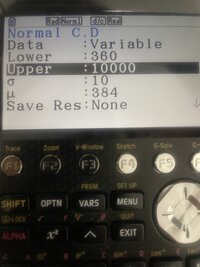The question is as follows: the time required to assemble bookcases is normally distributed with a mean of 48 minutes and a standard deviation of 10 minutes. Miller buys 10 of these bookcases. What is the probability that the total time it takes him to assemble all 8 bookcases is more than 6 hours?
multiply the mean by 8 to get 384 minutes. The average time taken to assemble 8 bookcases is 384 minutes. The standard deviation formula for a sample (as per my curriculum) is σ/√n , with σ being the population standard deviation and n representing the number in the sample.
so, I input this info into my graphics calculator to find the area to the right of 384.
Lower: 360
Upper: 10000
σ: 10/√8
μ: 384
The resulting probability is 1. But the answer is actually 0.9918 which corresponds to letting σ = 10. Why is it that σ/√n is not used in this case as the standard deviation when the 8 bookcases are a sample of 8 from the overall population of bookcases?
multiply the mean by 8 to get 384 minutes. The average time taken to assemble 8 bookcases is 384 minutes. The standard deviation formula for a sample (as per my curriculum) is σ/√n , with σ being the population standard deviation and n representing the number in the sample.
so, I input this info into my graphics calculator to find the area to the right of 384.
Lower: 360
Upper: 10000
σ: 10/√8
μ: 384
The resulting probability is 1. But the answer is actually 0.9918 which corresponds to letting σ = 10. Why is it that σ/√n is not used in this case as the standard deviation when the 8 bookcases are a sample of 8 from the overall population of bookcases?

